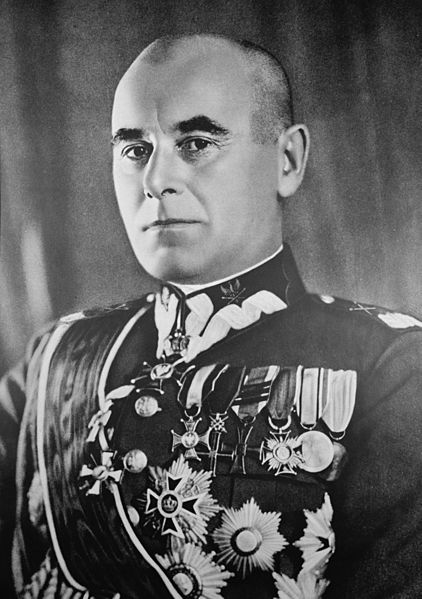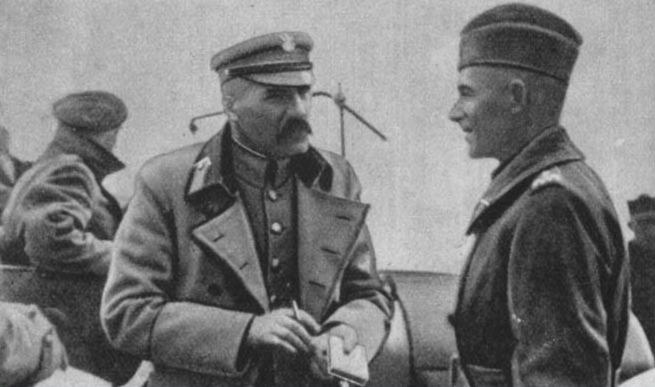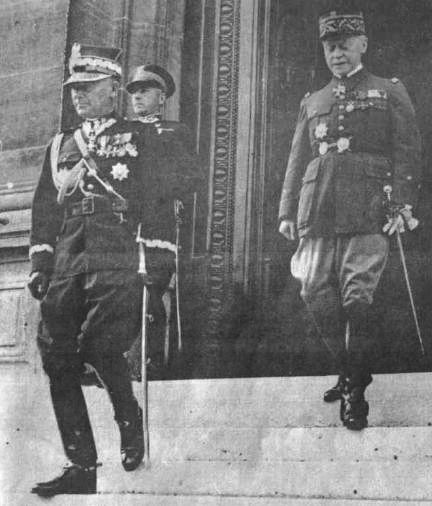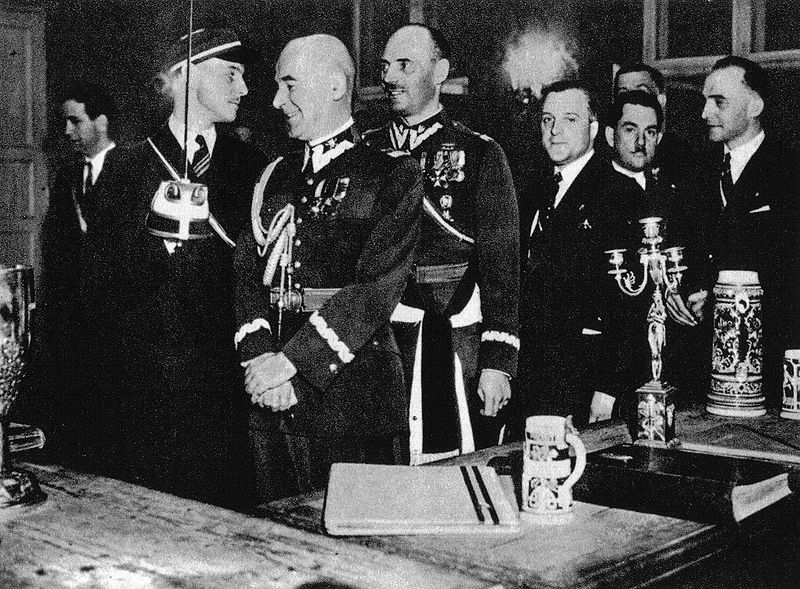<Back to Index>
- Marshal of Poland Edward Rydz - Śmigły, 1886
PAGE SPONSOR


Marshal Edward Rydz - Śmigły, before 1922 Edward Rydz, from 1922 onward Edward Śmigły - Rydz (11 March 1886 - 2 December 1941); nom de guerre Śmigły, Tarłowski, Adam Zawisza) was a Marshal of Poland, Polish political figure, Commander - in - Chief of Poland's armed forces, and a painter and poet. After many earlier successes as an army commander during the Polish - Soviet War, Rydz succeeded Marshal Józef Piłsudski as General Inspector of the Armed Forces in 1935, following Piłsudski's death. He served in that capacity during the Invasion of Poland, which marked the beginning of World War II.
Edward Rydz was born in the village of Łapszyn (now Lapshin in Ukraine) near Brzeżany, Galicia, Austria - Hungary. He was the son of a professional NCO in the Austro - Hungarian Army, Tomasz Rydz, and Maria Babiak. The family endured rather humble circumstances and he was orphaned at the age of 13 years. He was then raised by his maternal grandparents and, after their deaths, by the family of Dr. Uranowicz, the town physician at Brzeżany. After graduating with distinction at the local Gymnasium Rydz went to Kraków where he completed studies in philosophy and history of art at the Jagiellonian University. He then studied to be a painter at the arts academy in Kraków, and later in Vienna and Munich. In 1910 - 1911 he attended the reserve officers' academy in Vienna, and received military training at the famous Austrian 4th Infantry Regiment "Deutschmeister" (so called after Archduke Eugene, a cousin of Emperor Franz Joseph I, who was Grand Master of the Teutonic Order).
He finished his military education with distinction and was offered a commission in the Imperial Army, which he declined. In 1912 Rydz was one of the founders of the Polish paramilitary organization Riflemen's Association (Związek Strzelecki). At the same time he completed his art studies. He was regarded as a very promising talent in landscape and portrait painting, and praised by his professors and critics, who foresaw a great future for him.
Drafted into the Austrian Army in July 1914, Rydz was transferred in August to the Polish Legions and fought in World War I in the famous Polish 1st Brigade of Piłsudski. He took part in many battles against the Russians in the region of Southern Vistula, and rose quickly in rank. By 1916, he was already a full colonel. However he did not forget his art and exhibited his work at a gallery in Kraków. In 1917, after refusing to swear an oath to the Austrian and German authorities, the Legions were disbanded, their soldiers interned and Piłsudski imprisoned in Magdeburg fortress. By Piłsudski's appointment, Rydz (who escaped prison on the grounds of bad health) became commander of Polish Military Organization (POW) and adopted the nom de guerre Śmigły (Fast or Agile), which he later added as an integral part to his surname.
In October 1918 Rydz entered the socialist government of Ignacy Daszyński in Lublin as Minister of War. Having been promoted to brigadier general (the equivalent one-star general in the Polish army), he emphasised that he had accepted the office as a depute of Piłsudski. It was at this time he began using the double-barrelled name of Rydz - Śmigły. On 11 November 1918 the Government relinquished all power to Piłsudski, who became Provisional Head of State. After some hesitation, Piłsudski (who was displeased by Rydz - Śmigły's cooperation with the socialists – he himself "having left the streetcar of Socialism at the stop called Independence") confirmed him as a brigadier.
During the Polish - Soviet War (1919 - 1921), Rydz commanded Polish armies in several offensives. Among the victorious engagements, he captured Wilno and Dünaburg. After that, he was appointed Commander - in - Chief of the Latvian armed forces, and liberated Latgale from Red Army. Subsequently, he completely annihilated the Red Army's 12th Division and took Kiev. He then commanded the Central Front of Polish forces during the Battle of Warsaw, known as the Miracle on the Vistula. In this decisive battle, Polish commander Józef Piłsudski outwitted the Soviet commander Mikhail Tukhachevsky. Rydz - Śmigły's Central Front held against the Soviet attack, and later blocked the escape routes for the defeated 4th and 15th Armies and the 3rd Cavalry Corps of Soviet General Gayk Bzhishkyan, which had to flee ingloriously to East Prussia, where they were interned by the Germans.
After the 1919 - 21 war he was appointed the Inspector - General of the Polish Army in the Vilna district and later in Warsaw. In 1926, during Piłsudski's coup d'état (the May Coup), he took the Marshal's side and sent troops from Wilno to reinforce anti - government troops in Warsaw. Piłsudski never forgot this fidelity and in 1929 Rydz was appointed as the Marshal's deputy on all matters concerning the East. On 13 May 1935, following Piłsudski's death, Rydz was nominated by the President and the Government of Poland to serve in the capacity of the Inspector General of the Polish Armed Forces (the highest Polish military office). This was done in accordance with Piłsudski's wishes. Piłsudski's death saw his followers (the Sanacja), divide themselves into three main factions: those supporting President Ignacy Mościcki as Piłsudski's successor, those supporting Rydz, and those supporting prime minister Walery Sławek. With a view to eliminating Slawek from the game, Mościcki concluded a power-sharing agreement with Rydz - Śmigły, which saw Slawek marginalized as a serious political player by the end of the year. As a result of this agreement, Rydz - Śmigły was to become the de facto leader of Poland, until the outbreak of the war, whilst Mościcki remained influential through continuing in the highest office of president. From 1935, Rydz saw himself rapidly elevated in rank and position. On 15 July 1936 he was officially awarded the title of "Second Man in the State after the President", by the Polish prime minister. On 10 November, he was promoted to the rank of Marshal of Poland. Rydz's image as Piłsudski's anointed successor was popularized by the Obóz Zjednoczenia Narodowego movement, but alienated many of Piłsudski's supporters, offended by what they saw as Rydz's acts of self promotion.
The period of Rydz's rule, 1935 - 39, was often referred to as "a dictatorship without a dictator". Rydz lacked the moral authority of Piłsudski, and the piłsudskites were bitterly divided after 1935. The ruling regime was divided between the Mościski faction (known as the 'president's men' or the 'castle group'), made up mainly of civilians, and Rydz's group, known as the 'Marshal's Men', made up mostly of old comrades of Piłsudski and professional officers. Besides these two major groups, were the supporters of Slawek and other disgruntled piłsudskite groups, which were deprived of influence following the Rydz - Mościcki pact.
The regime became increasingly authoritarian and conservative. This was exemplified by the creation of the Obóz Zjednoczenia Narodowego (Ozon) movement. Ozon never achieved its goal of developing into a popular mass movement, and transforming Rydz into "Poland's second great leader" (after Piłsudski himself). Several of Poland's powerful politicians, including foreign minister, Józef Beck, and Mościcki himself, made a point of distancing themselves from this movement.
In March 1939, Hitler occupied Bohemia and Moravia and created the satellite client state of Slovakia. This encircled Poland with an iron ring on all sides except the east. Rydz was the only member of the government who clearly saw the impending danger of a conflict with Germany. However, time remaining was too short for the creation of completely new Polish operation plans in the west. During negotiations in Moscow during August 1939, Rydz refused all attempts by the Western Powers to obtain Polish permission for the Red Army to march westward, stating: "there is no guarantee that the Soviets will really take active part in the war; furthermore, once having entered Polish territory, they will never leave it".
On 1 September 1939 when the Germans invaded Poland, Śmigły - Rydz was named Commander - in - Chief of Polish forces. On 7 September, along with most of the government, he evacuated Warsaw as it came under attack. Soon afterwards, Polish coordination began to suffer from communications problems, which impaired Rydz's ability to command the forces. In Brest (Brześć) on 11 September he ordered that the Polish capital be defended at all costs. In his plan, Warsaw and the nearby Modlin Fortress were to become two redoubt citadels in central Poland, fighting on for months, while the bulk of Polish forces were to defend the Romanian bridgehead and await the counterattack promised by Poland's French and British allies. Unknown to Śmigły - Rydz, the Western Allies had no such plans and expected Poland's fall. His plan was further crippled when Soviet forces attacked Poland from the east on 17 September. Realizing that defense against both neighbors was impossible, Śmigły - Rydz issued orders for Polish forces to retreat towards Romania and avoid fighting the Soviet aggressors.
After avoiding capture by Soviet and German troops, on 18 September 1939 Śmigły - Rydz, escaped to Romania and was interned. The Polish government's crossing into Romania prevented Poland from having to officially surrender, and allowed Polish soldiers to carry on fighting against Nazi Germany, though Rydz's flight sparked some controversy, considering his position as supreme commander of the armed forces. Large numbers of Polish soldiers and airmen escaped into southern Europe and regrouped in France, and after her surrender, in Britain.
Marshal Śmigły - Rydz, as the Commander - in - Chief of Polish Armed Forces, took complete responsibility for Poland's military defeat in September 1939. Rydz was an extremely able Commander on smaller fronts, but was not an experienced strategist in a great conflict. In 1922, in an evaluation of Polish generals, Piłsudski had written about him: "in operational work he displays healthy common sense and a lot of stubborn energy. I could recommend him to everybody as a commander of an army, I am however not sure if he possesses sufficient abilities to function as commander - in - chief in a war between two states."
During his internment in Romania, Śmigły - Rydz initiated the creation of the Polish underground. This was based on officers who were loyal to the memory of Piłsudski. Still in Romania, on 27 October, he relinquished his function as the Commander - in - Chief and Inspector General of the Armed Forces. This role was assumed by Władysław Sikorski, who was serving in the new Polish government in exile in France (and after 1940 in the United Kingdom). Śmigły - Rydz was transferred from the internment camp to the villa of a former Romanian prime minister in Dragoslavele, from where he escaped on 10 December 1940 and crossed illegally into Hungary.
His flight to Hungary and rumours about his planned return to Poland were a source of considerable displeasure to his rival Sikorski, now Prime Minister. Sikorski had been in opposition to Śmigły - Rydz and Piłsudski from the time of the 1926 May Coup. Sikorski declared in a telegram to General Stefan Grot - Rowecki, leader of the Armia Krajowa (AK) underground resistance in Poland: "the Polish Government will regard a sojourn of the Marshal in Poland as a sabotage of its work in the country. The Marshal must as soon as possible move to some country of the British Empire". However Śmigły - Rydz left Hungary on 25 October 1941, and traveling through Slovakia reached Poland. On 30 October, in strict secrecy, Śmigły came back to Warsaw to participate in the resistance movement as a common underground soldier, thus voluntarily suspending his rank as Marshal of Poland. He managed to contact Grot - Rowecki, but remained incognito. He died suddenly of heart failure at the age of 55, on 2 December 1941, only five weeks after his arrival in Warsaw. He was buried in Warsaw under his alias "Adam Zawisza". His tombstone at the Powązki Cemetery bore that name until 1991. A new tombstone was erected by the people of Warsaw in 1994.
Rydz was married to Marta Zaleska, née Thomas, the couple was childless.
Edward Rydz - Śmigły's reputation after World War II was mixed. In socialist Poland and the Soviet Union, he was decried for his participation in the Polish-Soviet War in 1920, and the political repression under his military government of the late 1930s. In the West, due to the influence of anti - Piłsudski circles with Władysław Sikorski as their foremost representative, he was seen as having fled from the battlefield in 1939, with little recognition given to the circumstances of Poland's defeat by the Germans and Soviets.

